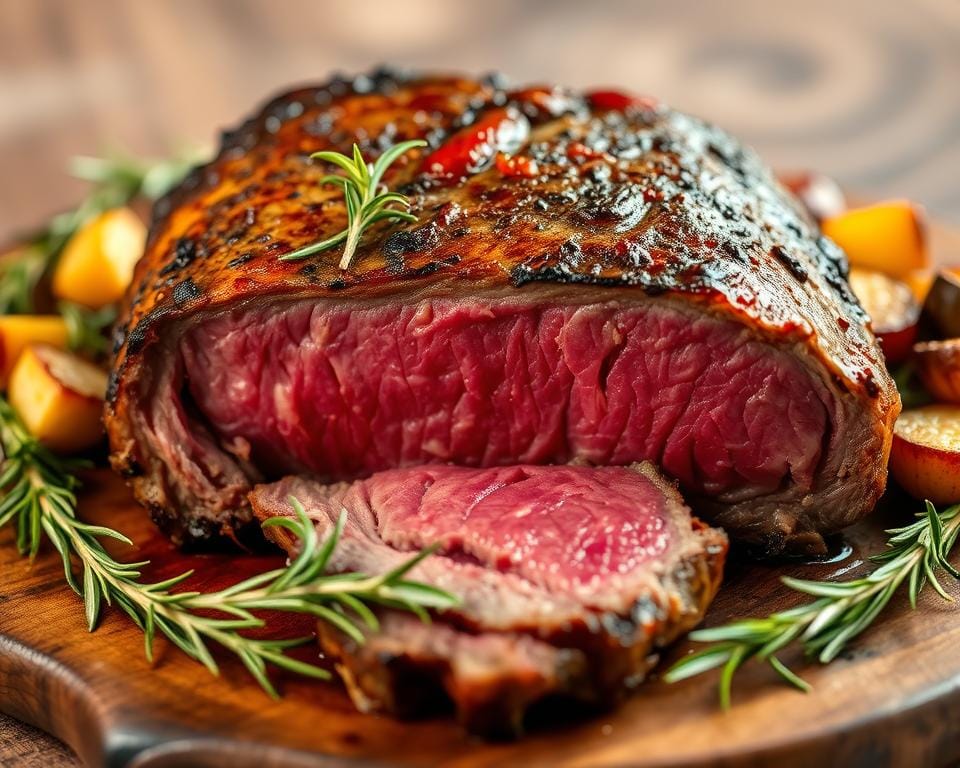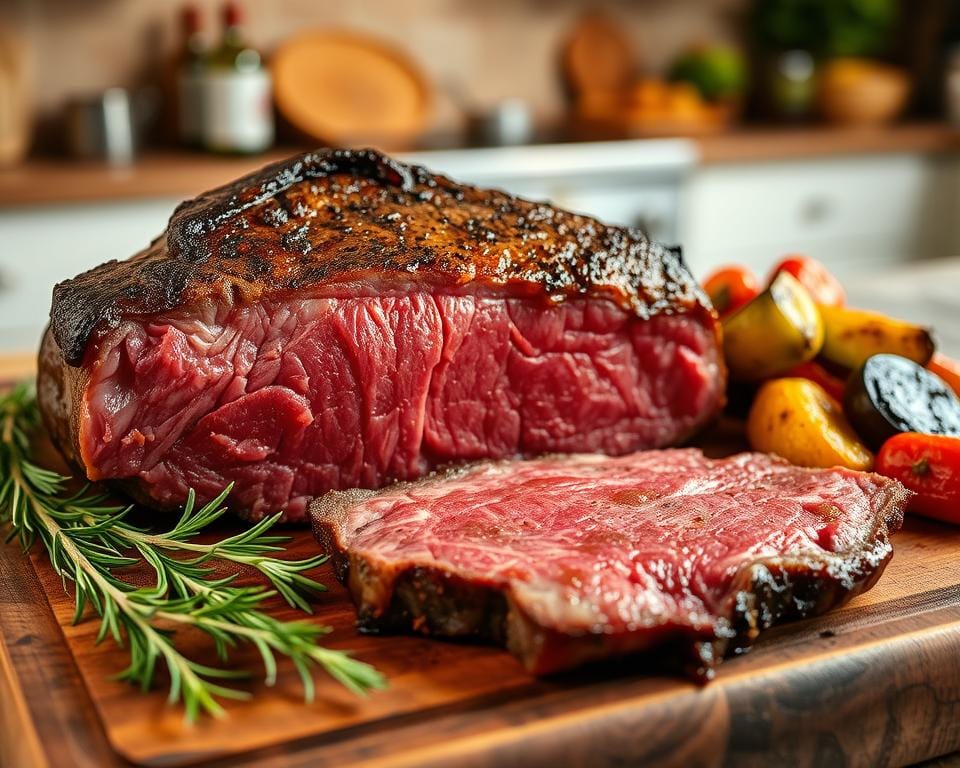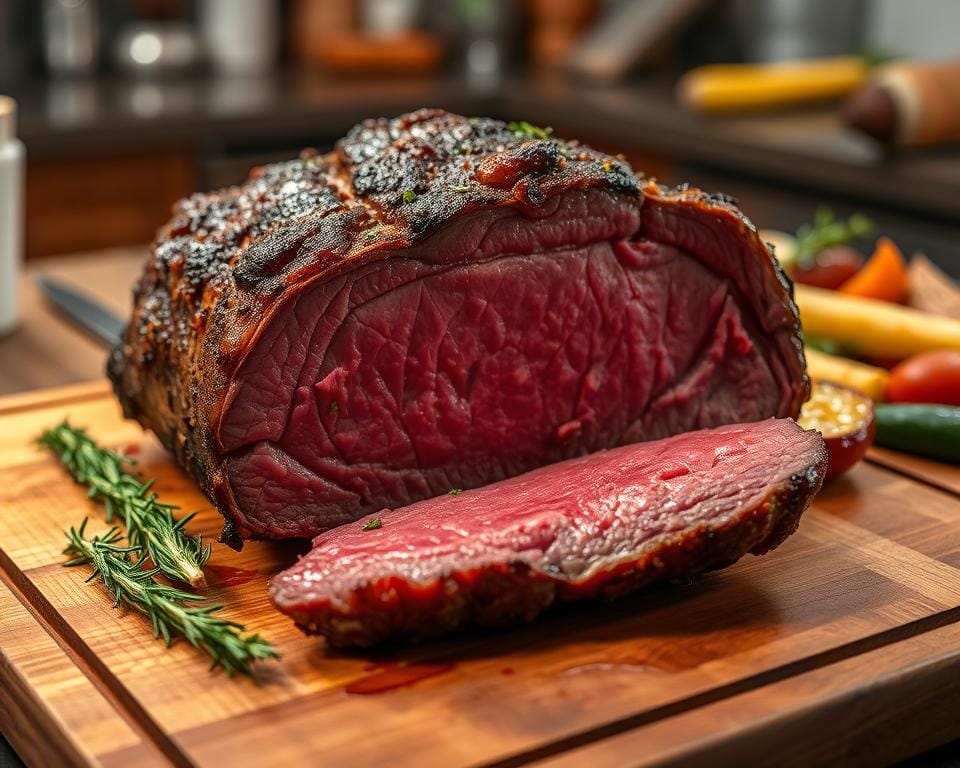Ribeye Roast: Tips for Perfectly Cooked Beef Every Time
The smell of a perfectly cooked ribeye roast brings back happy memories. It makes you think of family gatherings and special moments. The thought of enjoying that juicy, flavorful beef is exciting.
But cooking a perfect ribeye roast can seem scary. Don’t worry, with some tips and tricks, you can make a meal that rivals a restaurant’s. You can do it right in your own kitchen.
Table of Contents
Understanding the Ribeye Roast
The ribeye roast is a favorite cut of beef from the cow’s rib section. It’s the big muscle in the middle, called the “eye” of the roast. Look for meat that’s well-marbled and bright red. This is what makes it so tasty and tender.
Difference Between Prime Rib and Ribeye Roast
Though often confused, ribeye and prime rib are different. Prime rib is a bigger roast with more ribs. The ribeye is a single, boneless cut. Both are tasty, but prime rib is pricier because it’s bigger and has more ribs.
Meat Quality and Selection
Choosing a good ribeye roast is important. Grass-fed beef is loved for its rich flavor and health benefits. Conventional grain-fed beef might look more marbled. Also, bone-in ribeye roasts often taste more intense than boneless ones.
Benefits of Bone-in vs. Boneless
- Bone-in ribeye roasts are more flavorful, thanks to the bone.
- They can also be more tender, as the bone protects the meat.
- Boneless roasts are easier to slice and serve, perfect for some cooks.
Whether you pick a bone-in or boneless beef ribeye, it’s going to be delicious.
Essential Kitchen Tools and Equipment
To make a perfect ribeye roast, you need some key tools. First, a meat thermometer is vital for checking the roast’s internal temperature. This ensures it’s cooked just right. You’ll also need a strong roasting pan to hold the meat and catch all the juices. And don’t forget a sharp carving knife for slicing the roast neatly.
These three tools – the meat thermometer, roasting pan, and carving knife – are the basics for a great kitchen. They help you make a fantastic ribeye roast. Let’s look at why each one is important:
- Meat Thermometer: A good meat thermometer is key for the perfect doneness. It helps you get the roast to your liking, whether it’s rare, medium-rare, or medium.
- Roasting Pan: A top-notch roasting pan with a rack ensures even cooking. It keeps the bottom from burning and collects all the tasty juices for au jus or gravy.
- Carving Knife: A sharp, strong carving knife is crucial for slicing the roast nicely. A sharp blade makes clean, precise cuts that show off the roast’s juicy texture.
With these essential tools, you’re ready to make a delicious, restaurant-style ribeye roast. It will impress everyone. Remember, good tools are crucial for mastering this classic dish.
Perfect Temperature Control Guidelines
Getting the perfect doneness for your ribeye roast is all about mastering temperature control. Whether you like your beef rare, medium-rare, or well-done, knowing the right internal temperatures and resting times is key. This ensures consistently delicious results.
Optimal Internal Temperatures
For a rare roast, remove it from the oven when the internal temperature hits 105-110°F. For medium-rare to medium, aim for 110-115°F. And for well-done, pull it out at 130-135°F. Remember, the temperature will rise a bit during the resting time, so plan ahead.
Resting Temperature Guidelines
After cooking, let your ribeye roast rest for 30 minutes before carving. This lets the juices spread evenly, making the meat juicier and more flavorful. During this time, the internal temperature will go up by about 10 degrees Fahrenheit.
Using Meat Thermometers Effectively
A reliable meat thermometer is essential for precise temperature control. Stick the probe into the thickest part of the roast, avoiding bone or fat. Keep a close eye on the temperature and remove the roast when it reaches your desired doneness.
| Doneness | Internal Temperature |
|---|---|
| Rare | 105-110°F |
| Medium-Rare | 110-115°F |
| Medium | 125-130°F |
| Well-Done | 130-135°F |
Remember, proper cooking temperatures, meat doneness, and resting time are the keys to achieving a perfectly cooked ribeye roast every time.
Preparing Your Ribeye Roast
Preparing a perfect ribeye roast starts with a key step: drying the roast. Use paper towels to remove moisture from the packaging. This helps the roast cook evenly and get a nice crust.
Next, let the meat reach room temperature before cooking. This step, which takes 30 minutes to an hour, ensures the meat cooks evenly. It’s crucial for getting that juicy, pink center you want in your meat preparation.
After the roast has rested at room temperature, you’re set to cook. Follow the next steps for seasoning, searing, and roasting your beef to perfection.
| Cooking Time | Internal Temperature | Doneness |
|---|---|---|
| 1 hour 20 minutes | 125°F – 130°F | Rare |
| 1 hour 20 minutes | 130°F – 140°F | Medium Rare |
| 1 hour 20 minutes | 140°F – 150°F | Medium |
“A boneless ribeye roast recipe can be a good starting point for cooking a large cut of meat, as it is shockingly simple and forgiving.”
Seasoning and Marinade Techniques
To make your ribeye roast taste amazing, start with the right seasoning and marinade. Try a garlic butter mix with herbs and spices. This will create a delicious crust that keeps the meat juicy.
Garlic Butter Mixture
First, mix 1 cup of soft butter with 6 minced garlic cloves. Whisk until smooth. Then, rub it all over the ribeye roast. This garlic butter will give the meat a rich, savory taste that everyone will love.
Herb and Spice Combinations
- Italian Seasoning Blend: Basil, thyme, sage, oregano, rosemary, and coriander
- Southwestern Spice Mix: Chili powder, cumin, paprika, garlic powder, and cayenne pepper
- Herbes de Provence: Thyme, rosemary, basil, savory, and lavender
Try out different herbs and spices to find the best taste for your ribeye roast. Rub the mix all over the meat, making sure it gets into every corner.
Salt and Pepper Ratios
For seasoning, use kosher salt and black pepper. Start with 1 teaspoon of salt per pound of meat for a nice crunch. Add black pepper to taste, usually about 1/2 teaspoon per pound.
Learning to season and marinate your ribeye roast opens up a world of flavors. Experiment with different methods to find the perfect seasoning mix. This will make your ribeye roast the highlight of any meal.
Step-by-Step Cooking Method
To get the perfect ribeye roast, start with a simple cooking method. First, heat your oven to a very hot 500°F (260°C). This high temperature is key for creating a tasty crust on the outside of the meat.
After the oven is hot, put the ribeye roast on a wire rack over a baking sheet. Roast it for 20 minutes at this high heat. This step seals in the juices and prepares the meat for slow roasting.
- Preheat oven to 500°F (260°C).
- Roast the ribeye for 20 minutes at the high temperature to create a perfect crust.
- Reduce the oven temperature to 325°F (165°C) and continue cooking until the desired internal temperature is reached.
- Use a meat thermometer to monitor the internal temperature, aiming for 135°F (57°C) for medium-rare or 140°F (60°C) for medium.
- Plan for approximately 20 minutes of cooking time per pound of ribeye roast.
For a juicy, flavorful ribeye, always use a meat thermometer. It helps you get the perfect doneness, no matter the roast size.
| Doneness | Internal Temperature |
|---|---|
| Medium-Rare | 135°F (57°C) |
| Medium | 140°F (60°C) |
| Medium-Well | 145°F (63°C) |
By using this roasting technique, you’ll always get a perfectly cooked ribeye roast. You’ll enjoy a delicious oven temperature and cooking time that suits your taste.

Perfect Timing and Temperature Stages
Getting a perfectly cooked ribeye roast is all about the temperature stages. Start by searing the roast at high heat. This locks in juices and creates a flavorful crust. Then, slow roast it to cook the center to your liking.
Initial High-Heat Searing
Preheat your oven to 500°F (260°C). Place the seasoned ribeye roast in the oven and let it sear for about 20 minutes. This high heat makes a delicious crust on the outside, sealing in flavors and juices.
Slow Roasting Process
After searing, lower the oven to 325°F (165°C) for slow roasting. This slow cooking lets the center reach your desired doneness, from rare to medium-well. Use a meat thermometer to check the internal temperature.
The mix of high-heat searing and slow roasting makes a juicy, tender ribeye roast. Mastering these temperature stages is key to delicious results.
Resting and Carving Techniques
After cooking your ribeye roast to perfection, it’s time to let it rest. This step is key for spreading the juices evenly. It makes the meat moist and tender with every slice.
Take the roast out of the oven and cover it with foil. Let it rest for at least 30 minutes. This helps the juices get back into the meat. A rested ribeye roast will be easy to slice and taste amazing.
When carving, use a sharp carving knife and cut against the grain. This makes the slices thick and tender. If the roast feels jiggly, give it another 10 minutes before carving.
“Resting the meat is key to achieving a juicy, flavorful result. Don’t skip this important step!”
To make your dish look great, fan out the slices on a warm platter. Add fresh herbs like rosemary or parsley. This makes the dish look good and adds flavor to your ribeye roast.
Carving your ribeye roast well takes patience and care. Follow these tips to serve a delicious meat resting experience. Your guests will love it and want more.
Common Cooking Mistakes to Avoid
Cooking a perfect ribeye roast needs precision and focus. Avoid common mistakes that can ruin your dish. Pay close attention to temperature control and timing.
Temperature Control Errors
Not letting the meat warm up before cooking is a big mistake. A cold roast cooks unevenly, with the outside overcooked and the inside raw. Make sure the ribeye roast warms up at room temperature for at least an hour before cooking.
Not using a meat thermometer is another error. Relying on looks or the “poke test” can be wrong. Get a good meat thermometer and check the temperature often to get it just right.
Timing Miscalculations
Cutting into the roast too soon loses flavorful juices. The meat needs time to rest and let juices spread evenly. Wait at least 15-20 minutes before carving.
Wrong timing for cooking stages can also mess up your dish. Stick to the recipe’s instructions for searing, slow roasting, and resting. This way, you get a crispy outside and a juicy inside.

“Mastering the art of perfectly cooked ribeye roast is all about attention to detail and avoiding common cooking mistakes. With the right temperature control and precise timing, you can elevate your culinary skills and impress your guests with a truly exquisite dish.”
Serving Suggestions and Accompaniments
When serving your ribeye roast, the right sides can make a big difference. Try creamy mashed potatoes, roasted garlic potatoes, or grilled asparagus. Green beans, Brussels sprouts, and sautéed mushrooms also pair well, bringing out the beefy flavors.
Adding specialty sauces and toppings can add a special touch. Horseradish cream sauce and au jus are great choices. They let guests customize their meals. Serve with artisan bread, like rosemary focaccia or thyme dinner rolls, for sopping up juices.
Get creative with side dishes like roasted root vegetables. Carrots, parsnips, and sweet potatoes offer a nice contrast. You can also try salads with seasonal produce, like grilled peach and arugula or tomato and cucumber.
For a full meal, pair your ribeye roast with these tasty sides. You can mix and match to please everyone’s taste.
Recommended Side Dish Ideas:
- Creamy Mashed Potatoes
- Roasted Garlic and Butter Potatoes
- Grilled Asparagus
- Sautéed Mushrooms
- Roasted Brussels Sprouts
- Grilled Peach and Arugula Salad
- Tomato and Cucumber Salad
- Horseradish Cream Sauce
- Au Jus
- Rosemary Focaccia
- Thyme-Infused Dinner Rolls
There are countless ways to pair your ribeye roast with delicious sides. Don’t be afraid to try new combinations to please your guests.
Storing and Reheating Leftover Roast
Enjoying your ribeye roast means keeping it fresh. Proper storing leftovers and reheating techniques are key. They help keep the meat tasty and tender. Always follow food safety rules to avoid health issues.
For storing, put the leftover roast in an airtight container. Then, refrigerate it for 3-4 days. When reheating, be careful not to overcook. Use a low oven, stovetop with broth, or microwave in short bursts. Make sure it heats up to 165°F inside.
Leftover roast is great in sandwiches, salads, or as a side. Try it chilled with creamed wild mushrooms on puff pastry. It’s a fancy way to use up leftovers.
“Cooked beef stored in the refrigerator should be eaten within three to four days.”
Food safety is vital when reheating meat. Discard any meat that’s been between 40°F and 140°F for over two hours. This prevents foodborne illness.
Follow these tips to enjoy your ribeye roast for days. Every bite will be as delicious as the first.
Conclusion
Learning to cook a perfect ribeye roast is a skill that takes time. But with the right tips and techniques, you can make a meal that rivals a restaurant’s. Focus on controlling the temperature, seasoning, and letting it rest for the best taste.
Enjoy your ribeye roast with loved ones for a special meal. It’s a great way to make memories with your family and friends.
Whether you like your beef recipes rare, medium-rare, or medium, these cooking tips will help. With a bit of patience and care, you’ll impress everyone with a juicy, tasty ribeye roast.
The secret to a great ribeye roast is knowing the meat, using the right tools, and mastering cooking. Follow the advice in this article to make a meal that everyone will love.

